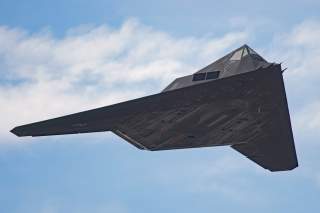F-117 Nighthawk: The Stealth Fighter That Started a Revolution
The first of its kind.
One of two missiles launched struck Lieutenant Colonel Dale Zelko’s Nighthawk. Zelko ejected and was recovered in a dramatic rescue operation, while his Nighthawk crashed to the earth relatively intact. Parts of it were squirreled away to Russia and China for inspection, but you can visit its remains today in the Museum of Aviation in Belgrade. As for Zelko and his nemesis Zoltan, they have since become friends and are even featured together in their own documentary series.
F-117s also were involved in strikes in Afghanistan as part of Operation Enduring Freedom, and returned to Iraq as part of the 2003 U.S invasion. Nighthawks actually kicked off the latter war on March 19, 2003 a day before the start of combat operations, in an attempt to kill Saddam Hussein at Dora Farms.
On to the Next, Stealthier Thing:
The Nighthawk was officially retired in in a ceremony on August 2008 after twenty-five years of operational service. Why?
Because of the entry into service of the F-22 Raptor, a stealth fighter that really is a fighter, and can also carry weapons for ground attack.
The Nighthawk’s radar cross section is generally given as .001 cubic meters—excellent compared to the 5 to 10 cubic meters of a conventional jet fighter. Nonetheless, the Raptor’s cross section is believed to be ten time better, at .0001 meters squared. Given the continual improvements made to both low-and high-bandwidth radars in order to counter stealth fighters, minimizing the cross section is vital.
The Raptor is nearly three times as fast as the F-117, is highly maneuverable thanks to its vector-thrust engines, and can carry both air-to-air and air-to ground munitions. The Raptor also has an Active Electronically Scanned Array (AESA) radar that can be used while keeping the fighter relatively stealthy. Moreover, the Raptor is less expensive to operate than the Nighthawk, which required more extensive repainting with radar absorbent coatings.
Thus the F-117 was retired three years early to free up money to purchase additional Raptors, of which only around 120 are in operational units. Other stealth aircraft in service include the F-35, a cheaper and less high-performing multi-role fighter than the Raptor that nonetheless boasts superior datalinks and electronic warfare capabilities. For ground attack carrying heavier bomb loads, there is the B-2 Spirit and the new B-21 Raider.
At first, the F-117s were placed in climate-controlled hangars in a condition to be reactivated if needed. A few were even spotted in 2014 flying on test missions. Yet in April this year, Congress finally authorized the Nighthawk’s full retirement.
For several decades, the F-117 offered the United States military a unique ability to slip through enemy air defenses and takeout high value targets with its precision guided bombs. However, the Nighthawk’s first-generation stealth technology limited the roles it could fulfill, and decades of advancement have pushed the envelope further in what stealth technology can achieve.
The Nighthawk nonetheless was the first step in a revolutionary development in modern aerial warfare, and paved the way for the more capable aircraft that will rule the skies of tomorrow.
Sébastien Roblin holds a Master’s Degree in Conflict Resolution from Georgetown University and served as a university instructor for the Peace Corps in China. He has also worked in education, editing, and refugee resettlement in France and the United States. He currently writes on security and military history for War Is Boring. This first appeared in 2016.

